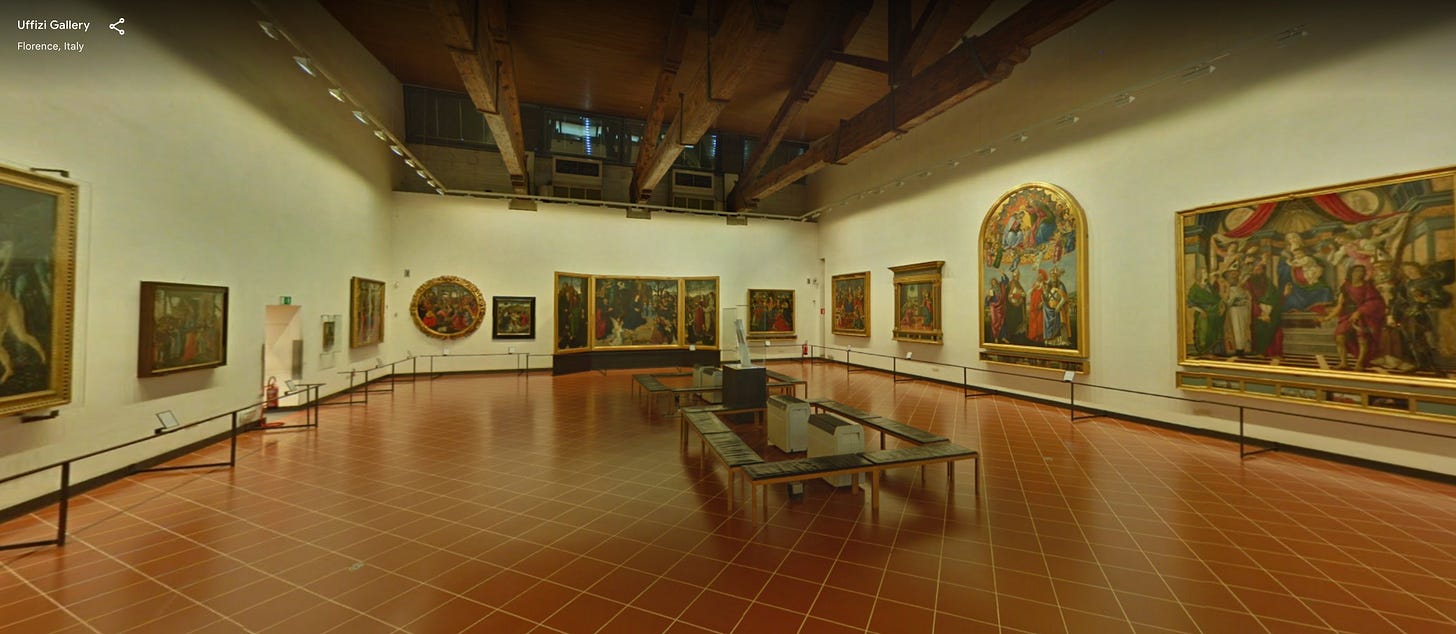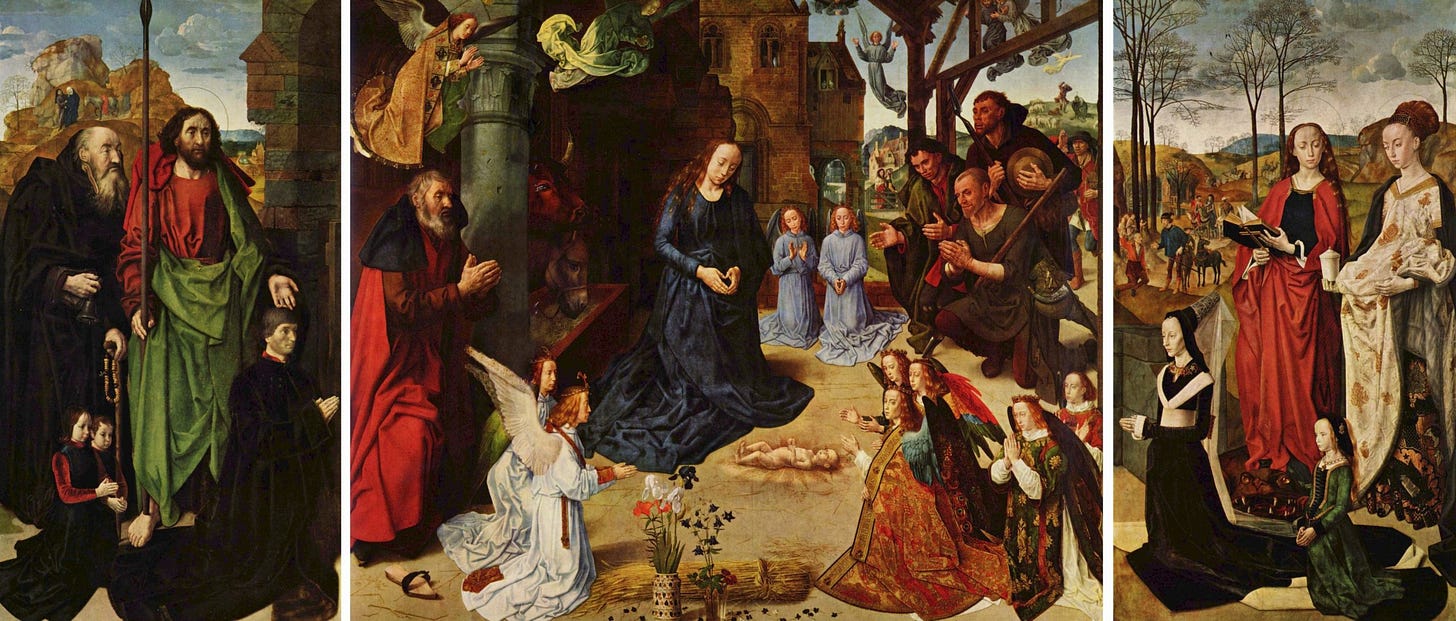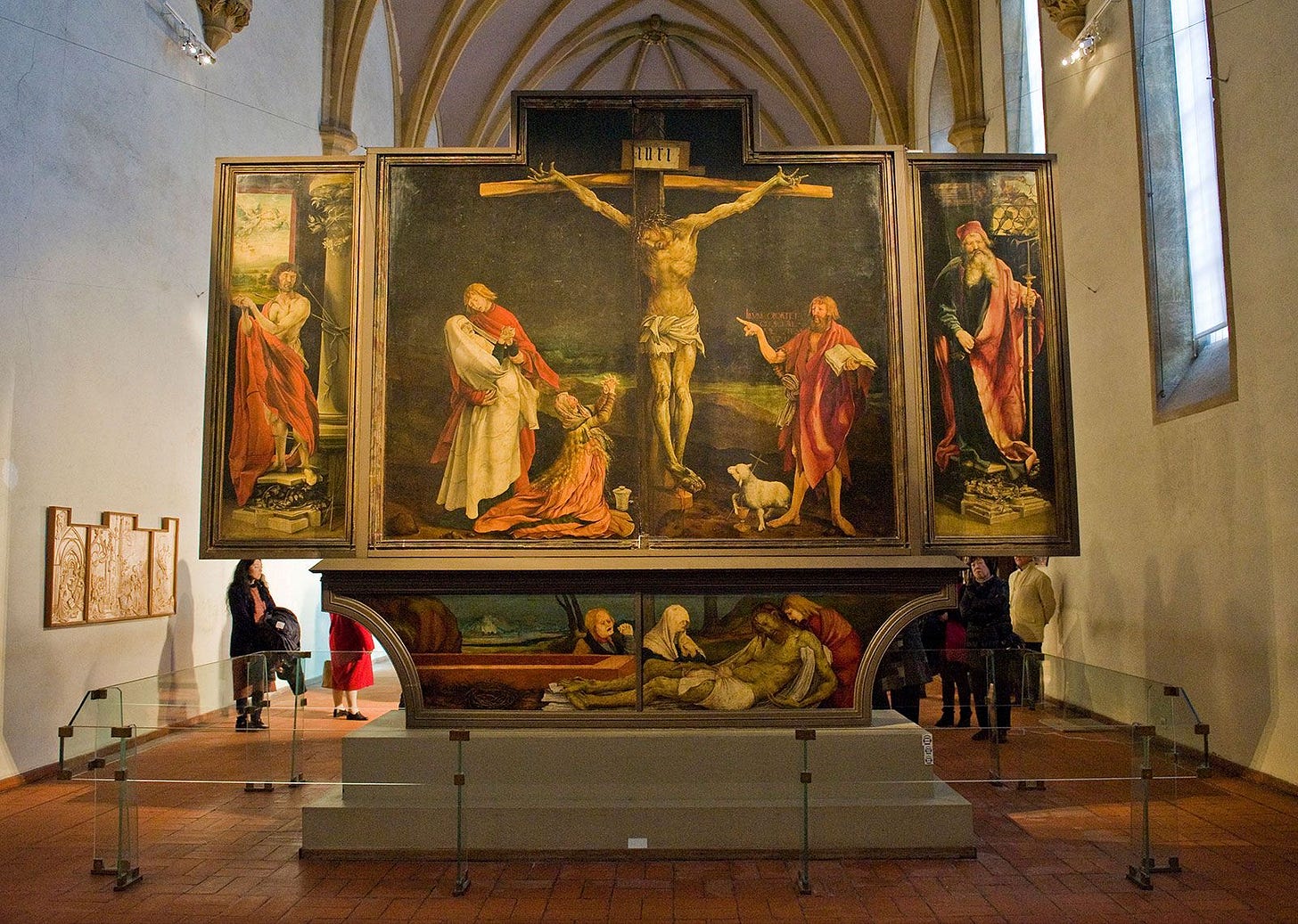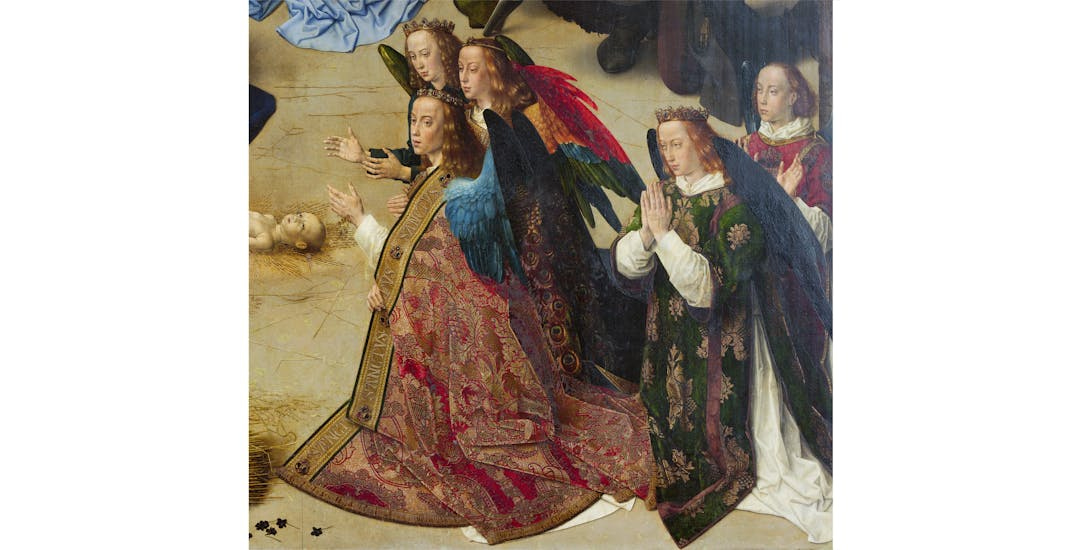I made a list of pieces to consider writing about in these essays. When I wrote down the Portinari Altarpiece, I had no idea what I would be writing about it. (1) You do not look at this painting like other works and think, "Oh, that reminds me of the time…" Few altarpieces do that. "Remember that time we saw the birth of the Savior?" Maybe the Isenheim Altarpiece conjures up a direct relation, but only if you lived in the early 16th century, suffered from the plague, and were set to have a leg amputated to save your life, which it did not. At best, you would have a brief, painful connection with Grünewald. (2)
My time with the Portinari Altarpiece was limited. It is housed in the Uffizi in Florence. I am fortunate to have visited there once. A quick look at the collections' highlights on their website will show you that a 3-hour tour is not going to get it done unless your only goal is to take a trip there in the summer and litter social media with your photos, with the hashtags "#breathtaking" "#art" "#kunst." My one trip might be my only trip. No complaints. You would have to be insufferable to say something like, "Well, I've only been to the Uffizi once." Instead of being significant to some other part of my life, seeing the art is the experience itself. It took considerable effort to stand in front of it.


I spent 15-20 minutes with this painting in a room with fifty other people, yet I was alone. The altarpiece is a triptych approximately 100" in height and 120" in length. It is not tucked away in a corner. The piece was installed on an elevated base commanding the wall it sat in front of, yet no one was looking at it. There is a good reason: it is in a gallery stacked with Botticellis. More importantly, it is as far away in the room as you can get from The Birth of Venus. At first, I thought that this was a mean-spirited curatorial move to put this piece in a room with such famous works. The painting deserves a separate room. However, by making it the oddball in the gallery, it automatically claims its own space.
Like the Mona Lisa, people descend upon Venus because "Oh my gosh, it's that Venus, take my picture." People with a committed interest in art often harbor a slight resentment toward everyone else in a museum because someone is always blocking their view, regardless of where they stand. It is not your fault. We are petty. It is like having a retail job for so long that you find yourself thinking, “I could really get a lot done if it weren’t for all of these customers.” If you have no museum experience, it is like being at the grocery store waiting for the person in front of you to figure out which brand of potato chips to buy while acting as if they have never seen potato chips before in their life. All you want to do is get the salsa sitting on a shelf directly behind their cart.
My experience with van der Goes might be the only time I will benefit from this “Oh my gosh, it’s that famous painting. Take my picture” mentality at the museum. By all means, stay thirty feet away from me and soak up the Neo-Platonism. I will check out this giant, northern European oddball masterpiece that found its way to Florence. Botticelli is not my jam. I stopped definitively trying to close the door on any artist as I got older, so I will allow that one day I might walk up to a Botticelli and have a Sherlock/Beautiful Mind experience where it all locks into place. But then again, I also might wake up one day and suddenly love The Smiths. (3) Each is highly unlikely to happen and even less likely with each passing year, but I must always consider that I might get hit in the head with something heavy and blunt.
When you know your time in front of a piece is limited, scan it and note things to look up later. "Look fast." Like my experience with the Dürer drawing, I understood there was a Colorforms methodology to the construction of this piece. If you had to guess, Portinari commissioned van der Goes to create an altarpiece of a specific size. Once he had determined the proportions of the measurements, he drew a rectangle, drew a line down the middle, and then subdivided it again vertically where the doors would be located. Now he had four sections of equal size and an assigned theme to fit into those spaces. He knew the figures, the symbols, and the narratives to be expressed. He rearranged all of that within the grid until it made sense as a scene with implied spatial dimension and as a flat space with shapes arranged within it. Suppose you have no experience making two-dimensional art that represents a three-dimensional space. You may not have ever considered the artist's responsibility to create the illusion of depth, but also consider the compositional ramifications of how things sit on a flat two-dimensional plane. Both are at work, together. That is the goal of this altarpiece. It may sound basic, but students often need reminding of this. They are so proud to have rendered depth, but then you have to say, "Yeah, but…" to them, and the magic is gone. A film student I knew in college said, "I used to like movies. Then I became a film major." Death by 1,000 "yeah, buts."
The altarpiece's figures, symbols, and other elements must revolve around a nativity scene. But it is not just the nativity. The piece condenses several events surrounding the birth of Christ into a single scene. There is an implication of time, but it lacks linearity. We can always say that something in the background is smaller, and therefore we know that it is in the past, and slowly work our way into the foreground to the present. I get that. That is why medieval artists used roads as lines to guide the viewer through the piece. Follow the road. Tell the story. But appreciate that a northern European "primitive" painter is not stupid and understands the simultaneity of how they depict separate times and events on the same plane. In the background alone, van der Goes presents the journey of Mary and Joseph to Bethlehem, the annunciation to the Shepherds, the travels of the Magi, and two women behind a gate that I am still trying to identify. It might be Mary visiting Elizabeth, but I am not sure.
The foreground of the central panel shows the infant, Jesus. He is more exposed and vulnerable than I can recall in any other piece. Lying on the ground, He is worshiped by Mary, Joseph, angels, the shepherds (freshly arrived from the background), a bull, a donkey, and observed by a shadowy angel hovering above the ox. It might be the first time in art history that someone has entertained the thought that Satan was a witness to the birth of Christ. Almost as if to counter that idea, an angel floating in that same quadrant is wearing a robe with Jesus' adult face repeatedly embroidered into the edging. This is a nativity, but embedded in the piece is the knowledge of what is to come. There are also symbolic objects and flowers in the foreground that point to Christ's eventual suffering and death, but I will not dive into that.
The foreground of the door panels depicts saints and patrons. The left panel shows the patron/banker Tommaso Portinari kneeling with his two sons, Antonio and Pigello. Saint Thomas and Saint Anthony accompany them. The right panel features Maria di Francesco Baroncelli (Portinari's wife) and the Portinaris' daughter, Margarita. This Portinari family is the same family that, about 200 years earlier, brought Beatrice Portinari into the world: Dante's muse. Mary Magdalen and Saint Margaret stand behind them. They are depicted as if they are worshiping alongside Mary, Joseph, and others. It is almost 1500 years compressed into one space. In addition to this disregard for linear time, the setting is hardly first-century Bethlehem. It is a somewhat ruined fifteenth-century Belgian city and landscape. This structure illustrates the simultaneity that northern Europeans sought, which Italians ignored. The Italians did not invest in historical accuracy, nor did they attempt to bring the Gospel into a contemporary context. Drawing the past into the present is one of the many gifts the Northern Renaissance has given us.
Occasionally, I give an assignment that focuses on balance and directional force at work in the altarpiece. It is not a trick question to ask what form of balance Portinari used in the piece. You are correct, regardless of your choice. If you want a gold star, you will acknowledge that approximately symmetrical forms hold together an asymmetrical composition with radial, diagonal energy to move you from focal point to focal point. All that overlaps, so there is rock-solid stability but also directional energy to keep your eye ever moving. I liken it to an episode of Frasier when Frasier and Niles compete to be cork master of the wine club, and a trick bottle is thrown in the competition to see who has the most sensitive palate. Both could discern individual components, but Niles came the closest to understanding how the parts related to each other. Hail, Corkmaster.
Your eye moves from figure to figure, but it briefly rests everywhere it lands. The presence of Christ stills everyone in the piece. There are at least twenty-nine figures in the foreground. Only three seem not to be looking at Mary or Jesus: St Margaret, a kneeling angel, and one of Portinari's boys. There is no question where to look. The angel that is not looking at Christ is breaking the fourth wall, not staring at you directly but staring outward as if to say, "Are you seeing this?" It is one of many direct ways to enter the painting. The angel is inviting you. If you miss that, almost every hand is pointed inward in a radial fashion, either to Mary or Jesus. Your eye follows all these pointing elements, but each figure or grouping is a self-contained unit. The defined edges of each component are what Heinrich Wölfflin would refer to as "linear," as opposed to the idea of "painterly," in his Principles of Art History. Explicitly delineated edges of forms. Look at the shepherds. That grouping looks like a Fathead sticker a kid would have on their wall. You feel that you could peel that entire section off and scoot it over an inch if you need to.
The same applies to the angels in the bottom right-center. If one angel moves, they all move. No unit or individual figure encroaches on another or acknowledges the presence of the other. It keeps every focus on Jesus, so you never have to wonder about the relationship between two different figures. Does Portinari get along with his wife? I do not know. I do not care. Your relationship with God is strengthened by being in community with fellow believers, but ultimately, your relationship with God is a personal one. Van der Goes does not encourage you to wonder how the brothers get along or what Saint Thomas and Anthony are doing later. There is a serenity and stillness in this piece that seems almost impossible to achieve, considering that approximately fifty figures, five narratives, three settings, and 1500 years are pushed together. Drama is not the goal. Contemplation is the goal. If you want a large painting with a lot of figures and endless drama, then you should head to the Vatican and sit in front of Raphael's Transfiguration or look at any Peter Paul Rubens. Figures interact in those pieces. They have animated facial expressions and melodrama not experienced again until the Marvel Universe sucked up all the money in Hollywood.
As with much pre-Dürer northern European art, van der Goes largely ignores linear perspective. I do not know if he knew it or not. He appears to grasp it in the Monforte Altar (The Adoration of the Kings), but it could also be a convincing approximation. It works architecturally, but if you look at the main magi's clothing, it flattens out in a gloriously northern way that does not obey the rules of perspective or fabric. The same observation applies to the figure behind him. He floats more than he sits back in space. I always appreciate this about the "primitives." Linear perspective is a tool, not a requirement. Why have one horizon line when you can have two or three? The floor is always pitched up from the back to allow for a more unobstructed view of "the stage." We did not need Cubism to reinvent space. Cubism broke the 400-year-old rules of the Renaissance, but, in some ways, it did not invent a new form of art. They dialed the clock back to existing possibilities that artists perfected before Brunelleschi sat down in the baptistry and demonstrated what vanishing points could do.
Christian art gets a bad rap for being too literal and narrative compared to other religions’ art. Blame Michelangelo and the Italians who followed him into the Baroque. Blame Rubens and the Counter-Reformation. The northern primitives had quiet on lock. Compared to Zen Buddhist painting or Islamic patterning, the Baroque provides too much information to digest, making it difficult to have a calm moment. They want you in awe of their spectacle, not lost in a moment of serenity.
The Portinari Altarpiece argues against that. Yes, a lot is going on, but it settles if you take a minute. You stand in the middle and stare at Jesus because everything in the painting tells you to look at Him. The piece is so large that it consumes the periphery of your vision, but everyone in the picture is doing the same as you, looking at Jesus. Nothing calls out to you from the edges to demand your attention should you choose to withhold that from the rest of the piece. You can quietly sit, and the altarpiece will be silent with you. It does not matter how many people thirty feet away from you are saying, "Oh my gosh, y'all, it's that Venus," in however many different languages are being spoken in the room while you are there. If you do acknowledge the other fifty figures in the work, if you move to the left or the right and think about it just as art, you are rewarded with a piece of sophisticated compositional construction that, for me, has no rival. Pick one of the many available entry points into the painting. One way or the other, you are going to end up in the middle, and you are going to be still and quiet and grateful that a curator put another masterpiece at the end of the room to distract people so you could have that moment.
I highly suggest Margaret L. Koster’s Hugo van der Goes and the Procedures of Art and Salvation from Harvey Miller Publishers. I did not intentionally take anything from the book in my reflections on this painting. Please consider this my attribution of source if I did.
You may never make it to the Uffizi Gallery in Florence. I hope you do. I hope I can return. To view the interior of the Uffizi, you can visit the Google Arts and Culture site. You can click through a slideshow of images to find a gallery shot of The Birth of Venus. Toggle the camera’s direction away from Venus to the other side of the room to see the van der Goes. At that point, you can “walk” up to the Portinari Altarpiece.
Matthias Grünewald’s Isenheim Altarpiece is located in Colmar, France. I have never seen this in person. The bottom panel of the altarpiece features the dead Christ mourned by three figures. I learned that his legs are positioned in a very particular part of the two panels on which they are painted. A door opens under his knees, separating the lower legs from the rest of the body. This separation acknowledges patients having their legs amputated to save them from the plague.
I owned The Queen Is Dead when I was in college, but failed to become a fan of The Smiths. I could create a playlist of their songs that I like, but I doubt a full album would truly capture my heart. The same could be said about Morrissey, although I enjoy Kill Uncle and Your Arsenal records. I think most fans consider Kill Uncle to be his worst. The album contains a song called "Sing Your Life." The opening line is "Sing your life/any fool can think of words that rhyme," and I found that bit of silliness inspiring when writing these essays.








Thanks for the deep dive. I am still regularly mystified about where and when multi-perspectival compositions started happening. There is always another layer to the onion.
I’ve also been to the Uffizi once, but at 17 I was much closer to the “Look it’s the ____ let’s take a selfie” than I’d like to admit, although that would have been about 4 years before the term ‘selfie’ was an option…